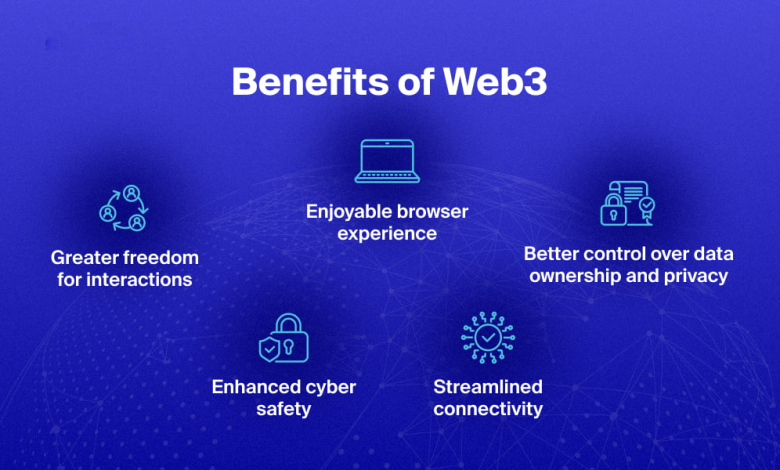Use Cases and Benefits- Blockchain applications in web3 e-commerce

Advantages of Web3 include decentralization and token-based economies. As a result, the user’s privacy is better protected.
Gavin Wood, creator, and co-founder of Ethereum, used the term “Web3” to describe the third generation of blockchain applications. He mentioned web3 technology when talking about Ethereum. He believes that the global technology ecosystem will thrive with web3’s implementation. Since it’s based on blockchain technology, it eliminates the need for intermediaries and returns power to the user. Advantages of Web3 include decentralization and token-based economies. As a result, the user’s privacy is better protected.
Blockchain Technology in Web 3.0 and Its Potential Applications Retail
The following benefits of web3 e-commerce are made possible by blockchain technology, the backbone of web3.
Inventory management- Similar to traditional shopping carts, retailers may use blockchain technology to keep track of sales and automatically replace inventory when levels drop below-predetermined thresholds.
Digital ownership- Although the store owner spent a lot of money on the images and films, the e-commerce platform is the official owner of the digital assets. However, with Blockchain, businesses may assert complete ownership over their virtual storefront, including all content, photos, videos, and customer reviews.
Loyalty reward programs- Personalized promotions and loyalty reward systems are now feasible with the help of Blockchain technology. A customer’s preferences and purchase history can be recorded securely on a blockchain. This paves the way for automating loyalty reward programs and individualized offers on the Blockchain.
Identity management- As more transactions occur online, the massive digital footprints left by individuals are becoming a major concern. Businesses may establish secure client authentication methods and encrypted digital identities using blockchain technology. This will aid in the protection of sensitive data and the improvement of identity management systems.
E-commerce companies can now easily monitor their supply chains thanks to blockchain technology. That way, you know the agreed-upon criteria are being met and that your suppliers aren’t sneaking in any inferior substitutes. The process can be scrutinized by anyone, from start to finish.
Taking care of warranties – Blockchain technology streamlines and accelerates the process of storing warranties for businesses. All parties involved in the market will have access to the data. As a result, warranty information may be easily validated and verified.
The Benefits of Blockchain Technology in Web 3.0 Business
Increased openness
Thanks to blockchain technology, businesses can operate without a central authority. Nodes, or participants in a peer-to-peer network, are crucial to this system since they verify and finalize monetary exchanges. Each node will keep a record of the transaction after verification is complete. Thus, a blockchain network preserves confidence by always making a complete record of all transactions available.
Safer Mechanisms
The distributed ledger technology known as Blockchain is currently the safest one. Each transaction is recorded using the consensus method, encrypted using a hashing technique, and linked to the one before. Each node in the network keeps a log of all blockchain transactions and their histories. This means that there is no way for hackers to access sensitive financial data.
Reduce costs
Most businesses place a premium on reducing costs. To verify the legitimacy of a possible business partner, companies no longer need to pay third parties. There will be fewer paperwork hoops before a deal can be sealed. Everyone will receive the same final copy.
Better monitoring
Forgery, loss, and theft are all issues that can arise from the inability to track purchases made through traditional online commerce easily. The supply chain can keep tabs on products thanks to blockchain technology to stop loss and theft.
Efficiency and speed
Since paper transactions required the involvement of numerous parties and were subject to human error, they could have been more efficient, error-prone, and time-consuming. The Blockchain’s streamlined architecture and built-in automation boost the procedure’s efficiency and speed. A centralized digital ledger stores all transaction records that all users can access. People are more likely to trust one another when they don’t have to rely on several intermediaries to meet their needs. It’s also conceivable for clearance and settlement times to decrease.
What changes should be made by brands in preparation for web3 e-commerce?
The web3 scene is always evolving; how can brands keep up?
Token gated commerce- Tokenized entry into the market needs first stimulate interest in blockchain technology and utility tokens, hence the “token gated commerce” concept. Consumers are more likely to spend money on your NFTs and more loyal to your brand, thanks to the integration of token-gated commerce between these technologies and online shopping.
Metaverse experience- You are well-equipped for your time in the Metaverse, as you are already familiar with personalized purchasing experiences’ influence on customer behavior. The Metaverse is no different. Customers are more likely to interact with your web3 presence if you provide them with metaverse experiences, such as product previews with customization that can be paired with customer avatars.
Gamify your shopping experience- If you want to attract a younger demographic, dip your toes into the gamification of the buying experience. NFTs can be used as a key to unlock exclusive services at various retail establishments. This will make it appear less like advertising and more like an interactive experience.
Take cryptocurrency as payment- This has been shown, at least among cryptocurrency enthusiasts, to increase sales. Accepting customers’ favorite cryptocurrency for purchases might boost your credibility.
How long till Web 3.0 does e-commerce become widely used?
Token gating for retail- In-store token systems In what is known as “token gating” for retail, customers are likelier to buy from a company that employs NFTs and dApps in its day-to-day business. According to Forbes, “The value of an NFT isn’t just in the asset, it’s also in what the buyer gets from the asset—and that is where you can start to build brand loyalty.” Future retail will prosper thanks to token-gated transactions and digital avatars for dedicated customers.
Increased funding for direct-to-consumer (DTC) initiatives- Web3 will decentralize companies prioritizing direct, one-on-one interactions with customers in response to the increasing flow of capital into the DTC model. More and more online retailers are adopting the direct-to-consumer (DTC) business model to stay competitive in the long run and attract a wider audience.
Omnichannel marketing- Customers value businesses that facilitate multiple communication channels with them. Omnisend found that retention rates for multichannel marketing are 90% higher compared to one-channel marketing. The most cutting-edge aspect of omnichannel marketing may be the tailored Web3 strategy. Customer avatars powered by AI will allow for more individualized service. Improved personalization at scale, made possible by Web3, could lead to higher customer retention rates in the long run, as customers place a higher value on “knowledgeable” firms.
Customer acquisition- Acquiring new customers with unfettered online access for marketers. Even better is when consumers actively seek out your advertising. Web3 will be less reliant on ads and more focused on collaboration. Customers in the web3 environment will be able to locate you using methods less typical in the web2 period, such as music streaming or in-game advertising.
B2B payments- The consumerization of business-to-business e-commerce. For instance, using Shopify Plus, you may employ B2C fundamentals like pricing flexibility and product personalization with B2B strategies like those outlined above. Services provided by a major Web3 development company in Dubai are democratizing connections between consumers and brands. We foresee that there will be even greater chaos between B2B and B2C deals in the future.
The supply chain- Logistics, transport, and the supply chain are all set to undergo profound changes due to the proliferation of blockchain technology. Blockchain’s ability to boost supply chain transparency and reduce logistical costs bodes well for these industries. The food distribution chain can be better understood if more information is shared. In a similar vein, you can monitor expiration dates to educate buyers.
Consumer engagement- As time passes, customers may become more receptive to NFTs and other crypto-based incentives. Many games now provide NFTs or cryptocurrency-based rewards to increase player loyalty and retention. Under Unix, users can earn rewards for competing in simulated tournaments. However, businesses outside the gaming industry are capitalizing on the collectibles craze by offering their versions of the items as NFTs.




